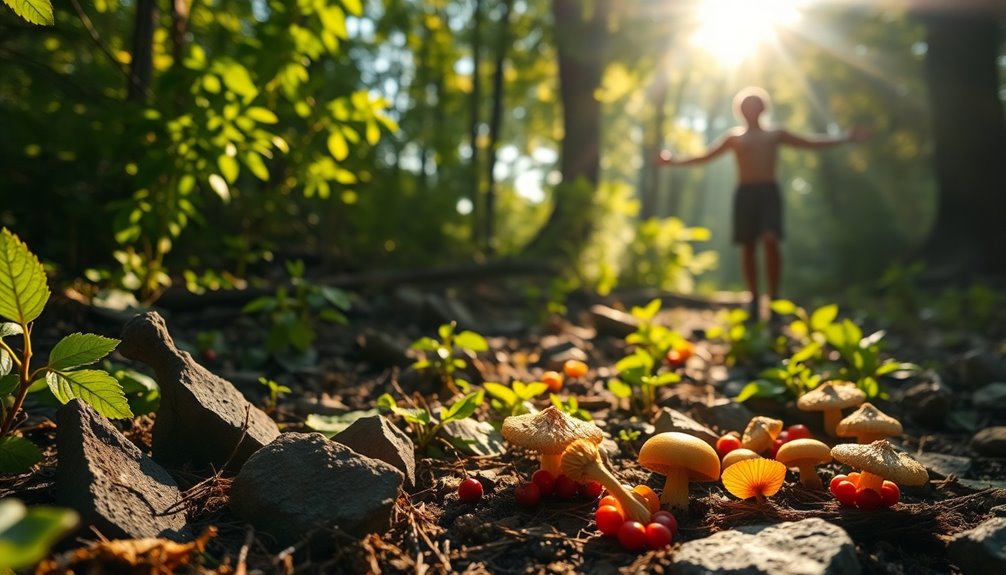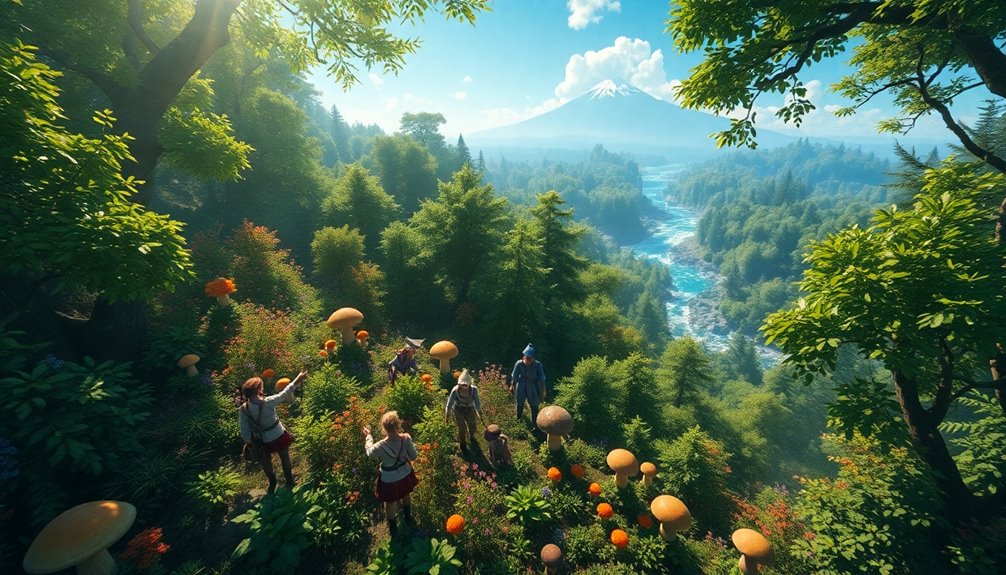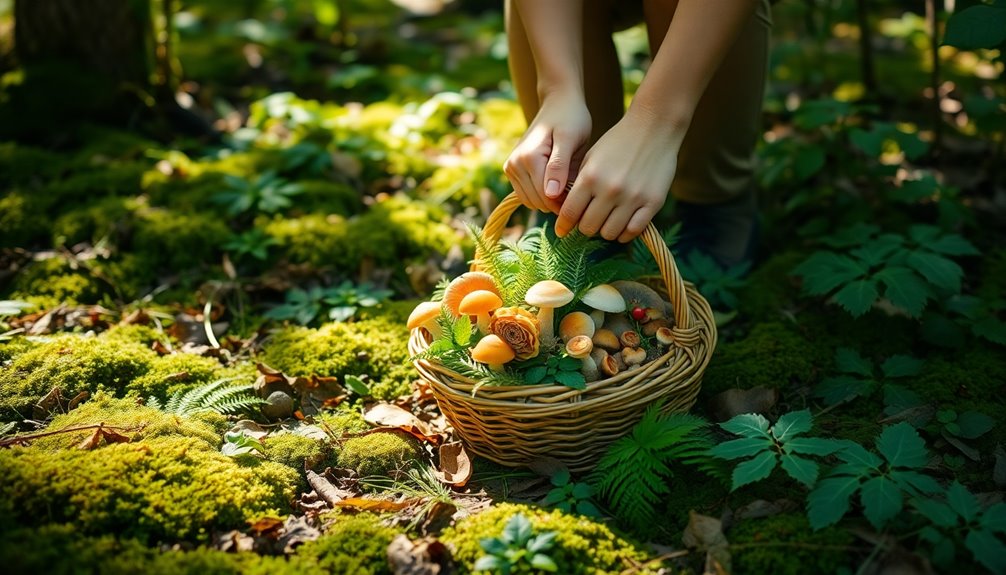Foraging began about 200,000 years ago when early humans relied on wild plants and animals for survival. During this time, you'd gather around 500 types of food each year, mostly from plants. This practice remained essential even after agriculture started around 12,000 years ago. As climate changed, so did your foraging techniques, enhancing your chances of survival. The use of tools improved your gathering efficiency, while social structures supported community bonds. If you're curious about how these ancient practices shaped modern nourishment and culture, there's even more fascinating history waiting for you to uncover!
Key Takeaways
- Foraging practices began approximately 200,000 years ago with the emergence of Homo sapiens.
- Early humans gathered around 500 food varieties annually, primarily plant-based.
- Foraging remained essential even after the advent of agriculture around 12,000 years ago.
- Specialized tools developed about 80,000 to 70,000 years ago enhanced foraging efficiency.
- Climate change continuously influenced foraging techniques and food availability throughout prehistoric times.
Origins of Foraging Practices
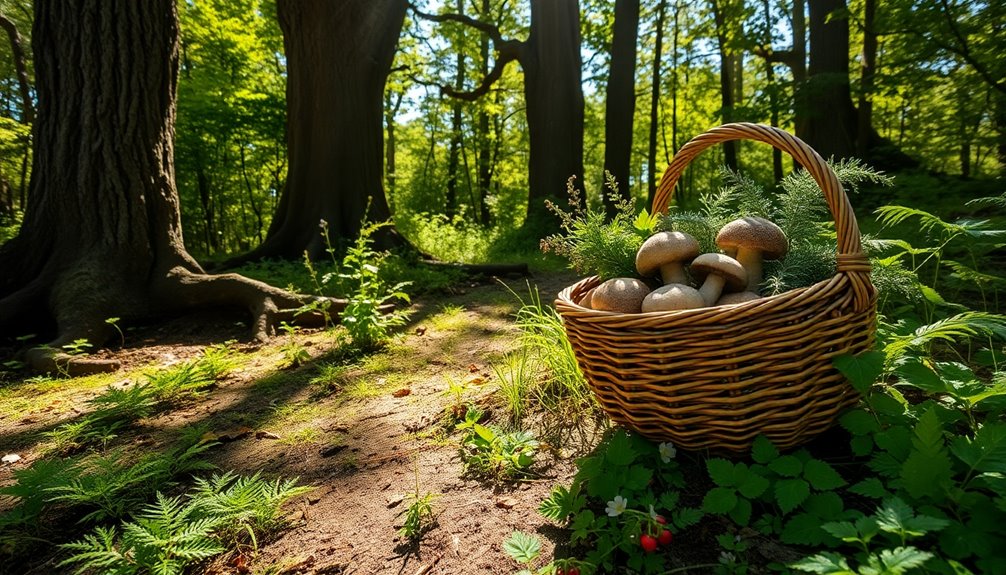
Foraging practices have roots that trace back about 200,000 years to the emergence of Homo sapiens, making it the primary way early humans sustained themselves. These practices weren't just a means of survival; they reflected a deep connection with the environment.
You'd find that early humans relied heavily on their extensive knowledge of local flora and fauna, gathering around 500 varieties of food annually. Archaeological evidence shows that their diets consisted of 60-80% plant foods, highlighting the importance of foraging in their nutrition.
Even with the shift to agriculture around 12,000 years ago, foraging remained a vital aspect of their diets. This adaptability is key to understanding how early humans thrived in diverse environments.
The endurance running hypothesis suggests that persistence hunting, a specific foraging strategy, played a significant role in human evolution. By honing these foraging practices, early humans developed skills that allowed them to exploit various resources effectively.
In essence, foraging practices weren't merely survival tactics; they were foundational elements that shaped the way early humans interacted with their world and adapted over millennia.
The Role of Hunter-Gatherers
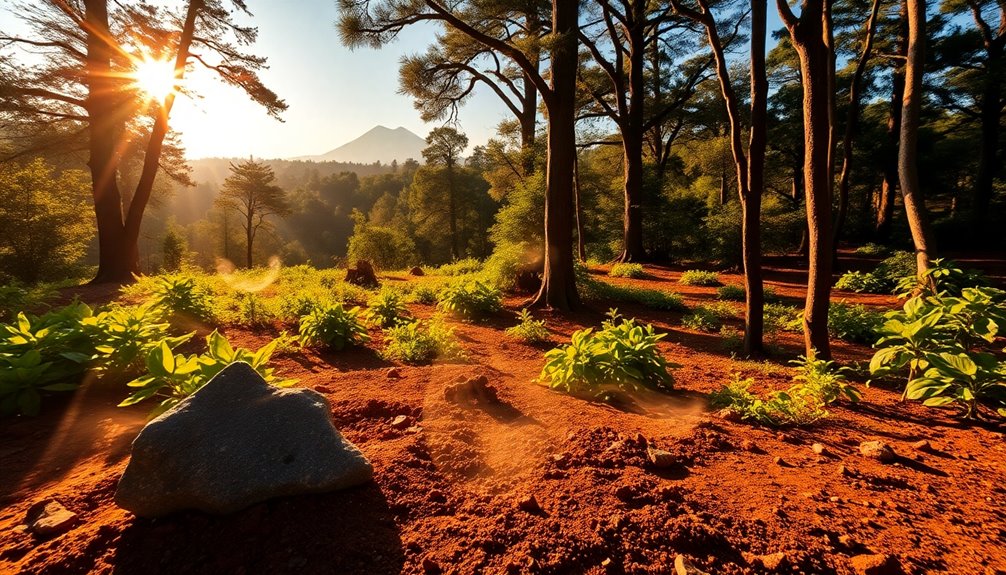
When Did Foraging Begin? The Ancient Secret Hidden in Prehistoric Times!
The Role of Hunter-Gatherers
Living as hunter-gatherers, early humans developed a lifestyle that deeply intertwined them with their environment. For roughly 200,000 years, these communities thrived by foraging for wild edible plants, insects, fungi, and game, making up 60-80% of their caloric intake. Unlike agricultural societies, hunter-gatherers typically engaged in subsistence work only 2-3 days a week, enjoying significant leisure time.
| Aspect | Details | Impact |
|---|---|---|
| Diet | Wild plants, insects, and game | Nutritionally diverse |
| Work Schedule | 2-3 days per week | More leisure time |
| Social Structure | Egalitarian, kinship-based | Strong community bonds |
| Gender Roles | Women hunt in 79% of societies | Challenged traditional views |
| Duration of Lifestyle | Approximately 200,000 years ago | Foundation of human existence |
Hunter-gatherer communities relied on resource sharing and close social ties, which fostered cooperation and resilience. Understanding their role in human history not only highlights their adaptability but also offers insights into the origins of social structures that continue to influence us today. Moreover, their lifestyle may have parallels with the concept of social bonds that are crucial for emotional well-being, similar to the benefits seen in pet therapy for dementia and Parkinson's patients.
Evolution of Food Sources
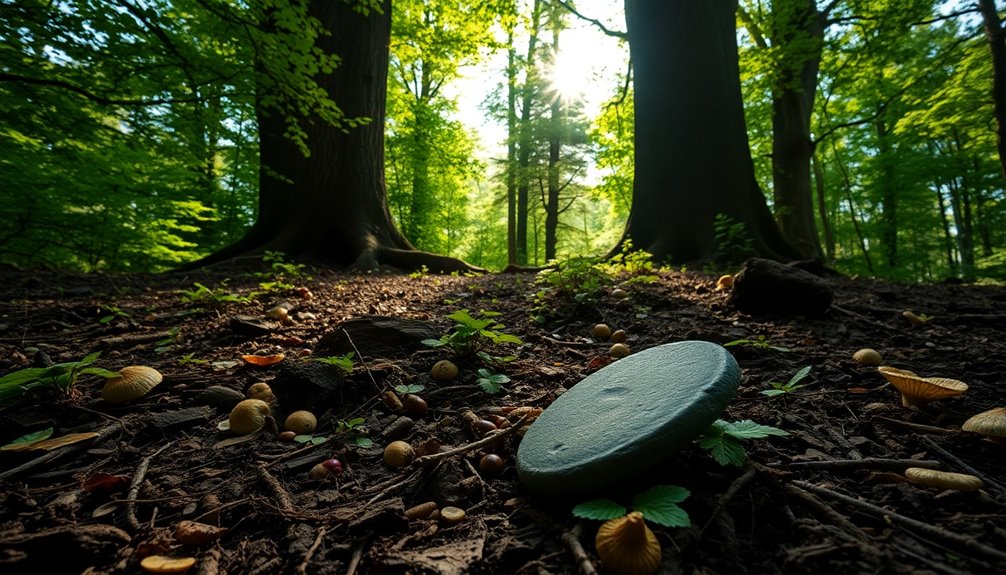
As you explore the evolution of food sources, consider how early foraging techniques shaped human diets and survival strategies.
Climate change played a vital role in influencing the availability of food, pushing hunter-gatherers to adapt their methods.
You'll see how these factors laid the groundwork for the eventual shift to agriculture.
Early Foraging Techniques
Throughout the early days of human existence, hunter-gatherers relied heavily on their surroundings to meet dietary needs. For about 200,000 years, they practiced hunting and gathering, harvesting wild edible plants, insects, and game. Evidence shows that plants made up 60-80% of their annual diet by weight, highlighting the critical role these foraged food sources played in their nutrition.
You'd be amazed at the extensive knowledge these early humans developed regarding local flora and fauna. They identified over 500 varieties of food annually and used seasonal calendars to track plant growth and animal breeding cycles, guaranteeing they knew when to forage or hunt.
Around 80,000 to 70,000 years ago, the emergence of specialized tools, such as fishing nets and harpoons, marked a leap in foraging efficiency.
Sustainable resource management was also key; these foragers minimized waste and guaranteed food sources remained available for future generations. By adapting to their environment and honing their skills, they laid the groundwork for the eventual shift to agriculture, but their early foraging techniques remain a tribute to human ingenuity and resilience.
Impact of Climate Change
The early foraging techniques developed by hunter-gatherers were continuously shaped by the changing climate. As the last Ice Age ended, you'd notice how climate change influenced food availability, prompting adaptations in foraging strategies.
With rising temperatures and retreating ice, diverse ecosystems emerged, allowing early humans to explore a variety of plant foods and animals. The shift from glacial to interglacial periods forced you to adjust your hunting techniques, focusing more on smaller game and seasonal foraging.
Key impacts of climate change on foraging included:
- Resource Availability: Increased temperatures led to a wider range of food sources.
- Diet Diversification: You began to exploit more plant foods, enhancing nutritional options.
- Seasonal Patterns: Foraging aligned with cycles of resource availability, adapting to changing conditions.
- Domestication: Gradual warming facilitated the domestication of plants and animals, setting the stage for agriculture.
These changes profoundly influenced your ancestors' diets, pushing them toward more sustainable practices that would eventually lead to agricultural development.
The legacy of climate change in shaping food sources continues to echo in our modern diets.
Social Structures in Foraging Societies

In foraging societies, you'll notice a strong emphasis on egalitarian social dynamics, where leadership shifts based on situational needs rather than permanent roles.
Kinship ties and band memberships create essential support networks, shaping how communities function.
Notably, gender roles blur as women often take on significant hunting responsibilities, highlighting their active contributions to the group's survival.
Egalitarian Social Dynamics
Amid the diverse landscapes of prehistoric times, egalitarian social dynamics defined hunter-gatherer societies. These groups operated under an egalitarian ethos, emphasizing equality among members. Leadership was situational and temporary, fostering a sense of shared responsibility and minimizing hierarchical structures.
You can see this in several ways:
- Kinship and Band Membership: Social ties were primarily based on family connections rather than rigid class systems.
- Temporary Leadership: Leaders emerged during specific tasks or challenges, ensuring that power wasn't concentrated in a single individual.
- Low Inequality: The average Gini coefficient of 0.25 among hunter-gatherers indicates some level of inequality but remains considerably lower than in agricultural or industrial societies.
- Specialized Roles: Evidence suggests the emergence of specialized roles in hunting and gathering activities about 80,000 to 70,000 years ago, highlighting the complexity within these egalitarian structures.
Gender Roles and Contributions
Egalitarian social dynamics in hunter-gatherer societies naturally influenced gender roles and contributions. Historically, both men and women played crucial roles in food acquisition, challenging traditional views that often depicted men solely as hunters and women as gatherers. In fact, studies reveal that women participated in hunting in 79% of modern foraging societies, demonstrating their significant contributions.
The table below summarizes the various contributions of gender roles in these societies:
| Gender Role | Contributions |
|---|---|
| Men | Primary hunters, larger game tracking |
| Women | Hunting small game, gathering, tracking |
| Both | Collective decision-making, resource sharing |
| Leaders | Situational leadership based on needs |
| All Members | Cooperation and adaptability |
In these social structures, leadership wasn't permanent and was based on immediate needs. This situational approach allowed for greater resilience and adaptability in response to environmental changes. By understanding gender roles in human history, you can appreciate how these diverse contributions shaped the survival strategies of our ancestors, fostering cooperation and resource sharing essential for thriving in challenging environments.
Kinship and Band Structure
Kinship and band structure form the backbone of social organization in foraging societies, fostering cooperation and resource sharing among members. In hunter-gatherer communities, these ties are crucial for survival and social cohesion.
You'll notice several key features in these structures:
- Egalitarian Ethos: Everyone has a role, and decisions often reflect the group's collective needs rather than a single leader's agenda.
- Situational Leadership: Leadership is flexible, emerging based on the specific context and expertise required, which allows for adaptive responses to challenges.
- Matrilocal Residence: Many societies practice matrilocal postmarital residence, ensuring that young mothers benefit from family support and communal resources.
- Gender Roles: Contrary to traditional views, modern studies show that women participate in hunting activities in 79% of contemporary hunter-gatherer societies, promoting a more fluid understanding of gender roles.
These kinship structures create a complex web of interpersonal relationships, ensuring mutual aid and resource allocation.
Through these connections, hunters and gatherers thrive, maintaining social bonds that are essential for their way of life. Additionally, the importance of community building in these societies highlights their resilience and adaptability in facing environmental challenges.
Tools and Techniques for Foraging
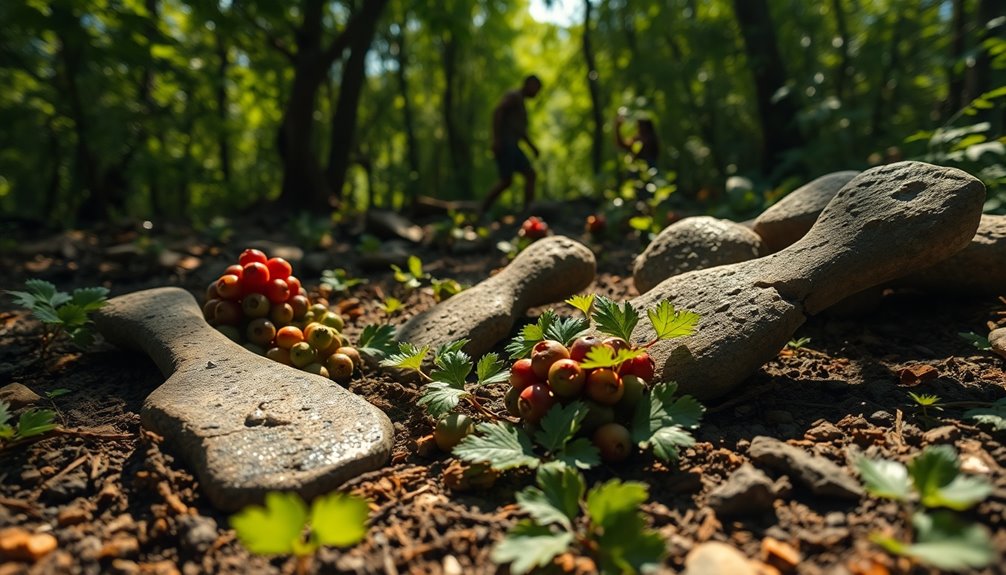
As foragers developed their skills, they also created specialized tools that greatly improved their ability to gather food. Archaeological excavations reveal evidence of fishing nets and harpoons, which enhanced efficiency in resource gathering.
You'd be surprised to learn that hunter-gatherers utilized over 500 varieties of food annually, showcasing their extensive knowledge of local flora and fauna for foraging.
To optimize their foraging techniques, prehistoric foragers employed seasonal calendars to track the growth cycles of plants and the breeding patterns of animals. By understanding these patterns, they could time their foraging activities more effectively.
Additionally, the controlled use of fire played a crucial role in their strategies, promoting seed germination and improving access to edible plants.
The endurance running hypothesis also highlights an innovative foraging strategy known as persistence hunting. This method required adaptability, allowing early human foragers to thrive in diverse ecological conditions.
Dietary Diversity in Prehistoric Times
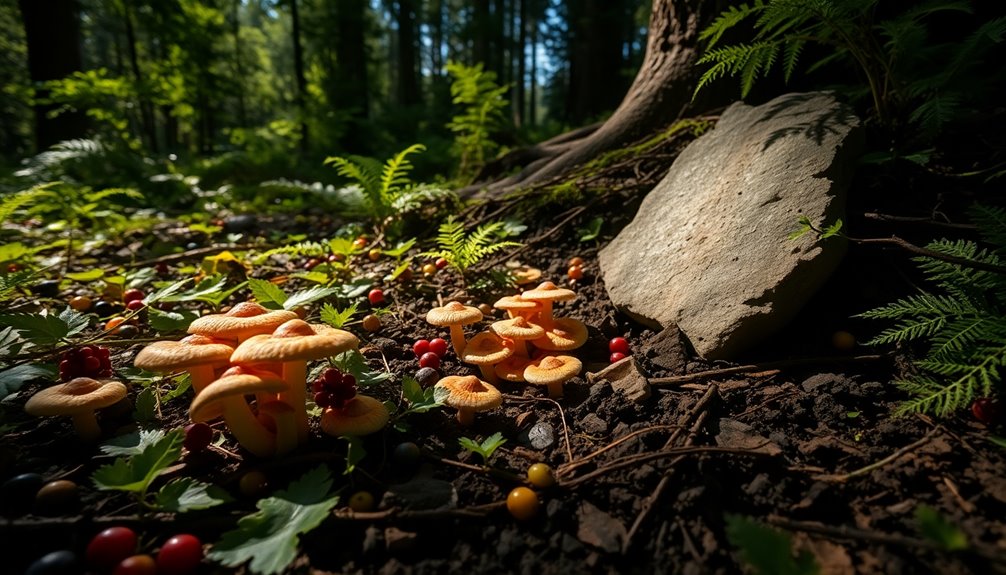
Prehistoric diets were anything but monotonous; they thrived on a rich tapestry of flavors and nutrients. The dietary diversity of hunter-gatherers during the Stone Age was impressive, with plant foods accounting for 60-80% of their annual caloric intake. They utilized over 500 varieties of food each year, showcasing their extensive knowledge of local flora and fauna.
To maintain this variety, prehistoric groups employed seasonal calendars to track key cycles, ensuring a sustainable diet throughout the year. Their approach to foraging included:
- Utilizing diverse plant species: They gathered fruits, nuts, seeds, and tubers, capitalizing on the seasonal availability.
- Hunting various animals: This included small game, fish, and larger mammals, depending on the region.
- Incorporating spices: Archaeological findings, such as garlic mustard seeds in pottery, indicate that they engaged in sophisticated culinary practices.
- Leisure time for exploration: With only 2-3 days of work each week to procure food, they'd ample time to explore new dietary options.
This rich dietary diversity not only met their nutritional needs but also contributed to a vibrant culture and lifestyle. Additionally, their diet likely included high omega-3 content from various seeds, which were essential for maintaining overall health and cognitive function.
Impact of Climate on Foraging
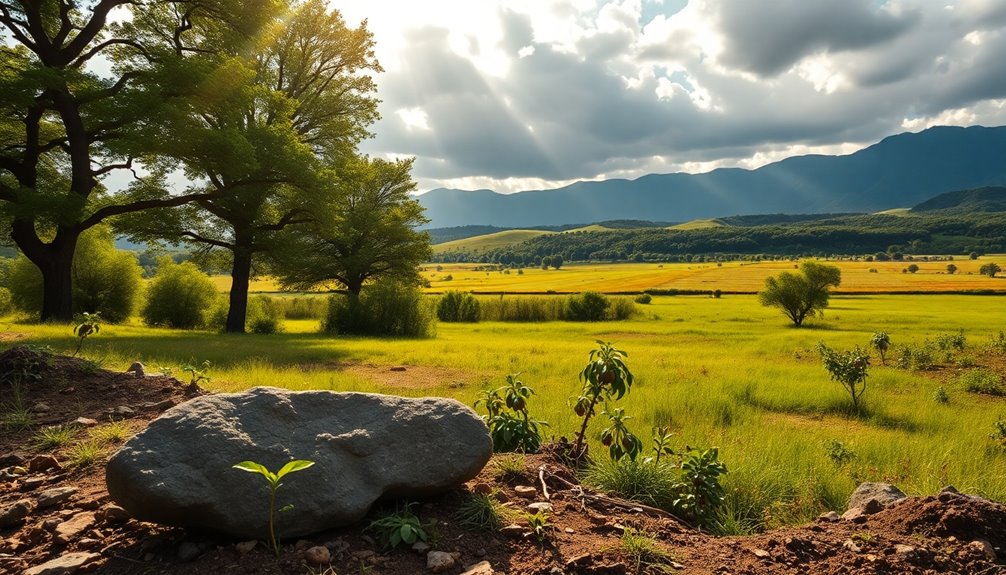
Climate played an essential role in shaping foraging practices among ancient human populations. During the Pleistocene epoch, fluctuations between glacial and interglacial periods affected the abundance of wild food resources. As the last Ice Age ended around 11,700 years ago, the world warmed, creating wetter conditions that expanded diverse flora and fauna. This shift allowed hunter-gatherers to enhance their foraging opportunities considerably.
With regional climates varying, foraging techniques adapted locally. You'd notice groups migrating seasonally to exploit different food sources, ensuring they always had something to eat. The evidence of plant and animal remains found at archaeological sites shows how these ancient people adjusted their strategies in response to climate changes, maintaining food security amidst environmental challenges.
In the Neolithic period, as climate continued to evolve, fewer hours were spent searching for food, thanks to more abundant and reliable sources. This adaptation was vital for survival, as it directly impacted the availability and distribution of edible plants and game.
Ultimately, understanding these climatic influences reveals how prehistoric societies thrived, showcasing their resilience in a changing world.
Transition to Agriculture
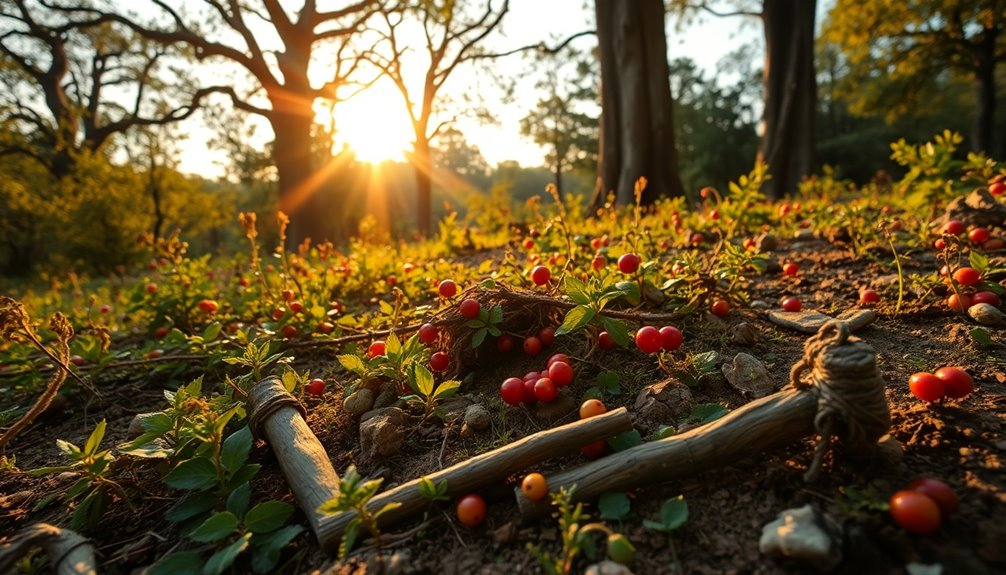
The shift from foraging to agriculture, often referred to as the Neolithic Revolution, marked a pivotal moment in human history. This change to agriculture began around 11,000 years ago, but evidence suggests that early agricultural practices may date back even earlier, with signs of wild grain exploitation identified as far back as 14,500 years ago.
Rather than being a sudden invention, the move toward farming was a gradual process influenced by various factors.
Here are four key aspects of this change:
- Environmental Changes: Shifts in climate and landscape created new opportunities for farming.
- Resource Availability: Increased access to wild grains and domesticable plants encouraged agricultural practices.
- Mixed Strategies: Early humans combined hunting, fishing, and foraging with nascent farming techniques for thousands of years.
- Crop Failures: Challenges and uncertainties in farming reinforced the importance of traditional foraging methods, delaying a complete reliance on agriculture.
In this complex evolution, the Neolithic Revolution laid the foundation for the societies and civilizations that would follow, fundamentally altering the human experience.
Archaeological Discoveries and Insights

Archaeological discoveries have shed light on the culinary practices of prehistoric hunter-gatherers, revealing that their diets were more sophisticated than previously thought. For instance, remnants of garlic mustard seeds found in a pottery fragment from Neustadt, Germany, date back at least 5,900 years. This shows that these communities used native spices long before agriculture became mainstream.
| Archaeological Site | Findings | Age (Years) |
|---|---|---|
| Neustadt, Germany | Garlic mustard seeds | 5,900 |
| Denmark | Crushed mustard seeds | 4,000 – 5,000 |
| Various Sites | Phytoliths (plant microfossils) | Thousands of years |
The microscopic analysis of food residues in Denmark and Germany also indicates that Stone Age societies were both complex and creative in their culinary practices. The identification of phytoliths serves as a "fingerprint," confirming the use of spices. These findings challenge earlier beliefs that prehistoric diets were solely focused on caloric intake, emphasizing the social dynamics and prestige associated with cooking in hunter-gatherer societies.
Modern Foraging Movements
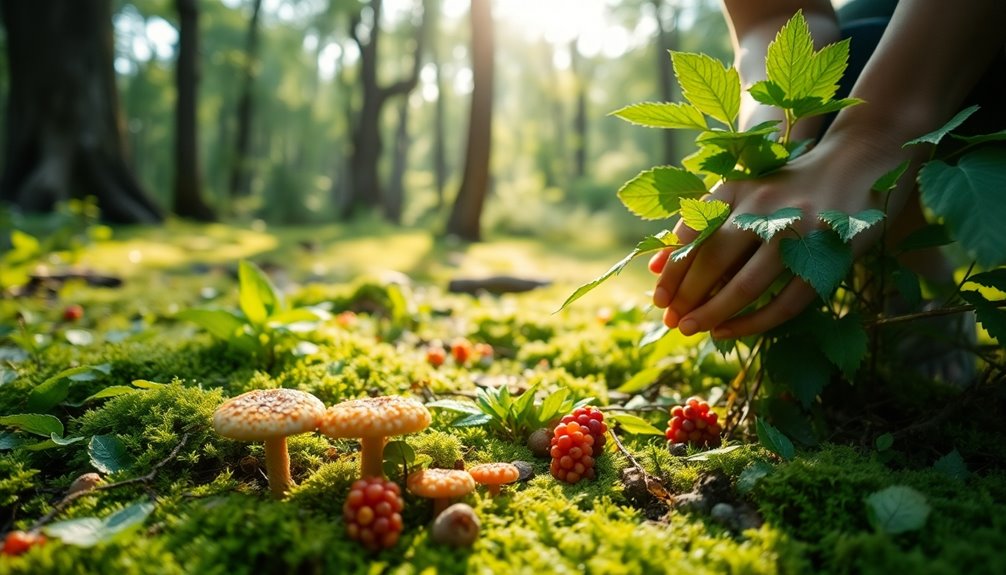
In recent years, a growing interest in foraging has sparked a movement that encourages people to seek out sustainable food sources and reconnect with nature. This shift isn't just a trend; it's a response to the drawbacks of industrial society and a quest for food sovereignty.
Here's how modern foraging movements are thriving:
- Workshops and Guided Trips: Organizations offer hands-on learning experiences, teaching you to identify edible plants and fungi safely. Additionally, understanding aromatherapy techniques can enhance your overall experience in nature by promoting relaxation and mindfulness.
- Urban Foraging: Many discover that city parks and gardens are teeming with edible plants, promoting biodiversity in urban environments.
- Community Engagement: Foraging groups create supportive networks, where you can share experiences and knowledge, enhancing your skills.
- Social Media Influence: Platforms like Instagram and Facebook allow enthusiasts to connect, share recipes, and document their foraging adventures, fostering a vibrant community. Additionally, understanding sustainable harvesting practices is essential to ensure that foraging activities do not harm local ecosystems.
Frequently Asked Questions
When Did Foraging Begin?
Foraging began around 200,000 years ago when early humans relied on wild edible plants for survival.
You'd gather diverse foods, with plants making up a significant portion of your diet. This practice shaped how communities interacted with their environment, using over 500 food varieties annually.
As agriculture emerged about 10,000 to 12,000 years ago, foraging slowly shifted to farming, but the skills and knowledge you gained remained essential for sustaining life.
When Did Humans Stop Being Foragers?
When it comes to evolving from foraging, you're looking at a significant turning point around 10,000 to 12,000 years ago.
People started trading their hunting-gathering lifestyle for agriculture during the Neolithic Revolution. This shift didn't happen overnight; it took time to blend farming with traditional practices.
Eventually, as societies grew, folks relied more on farming, putting aside foraging as their primary source of sustenance.
It's a classic case of adapting to survive!
Is Foraging Paleolithic or Neolithic?
Foraging primarily belongs to the Paleolithic era, when early humans relied on wild plants, animals, and fish for sustenance.
However, it didn't disappear with the rise of agriculture in the Neolithic period; instead, it coexisted with farming practices for thousands of years.
When Did the Hunter-Gatherer Era Start?
The hunter-gatherer era started around 2.5 million years ago, when early hominins began relying on foraging and hunting for survival.
You'd find these groups living in small, mobile units, constantly adapting to their environments. They exploited diverse ecosystems, gathering wild plants and hunting animals.
This lifestyle dominated human existence for about 95% of our history, shaping social structures and knowledge about local flora and fauna long before agriculture emerged about 10,000 to 12,000 years ago.
Conclusion
In the grand tapestry of human history, foraging weaves a rich thread that connects us to our ancient ancestors. Understanding its origins and evolution reveals not just how we survived, but how we thrived. As you explore the world of foraging today, remember it's more than just gathering food—it's a dance with nature, a celebration of our shared past. So, step into the wild, and embrace the secrets the earth has to offer. Your journey awaits!

